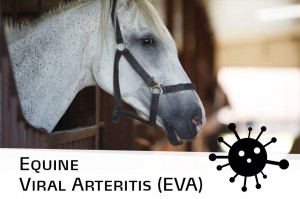
Equine Viral Arteritis (EVA)

Equine viral arteritis (EVA) is a contagious disease that affects horses, ponies and donkeys. The clinical signs usually show up 3 to 14 days after the animal is infected and they can be more or less severe. In some cases, clinical signs are so mild that they will not be detected and some animals may not show any signs at all (carriers).
This condition can cause fever, depression, lethargy, nasal discharge, inflammation around the eyes (conjunctivitis), oedema (swelling) of the testicles or udder and around the limbs, which leads to a stiff movement. The virus involved may also cause abortion in pregnant mares and if infected, young foals can suffer from severe respiratory disease.
EVA is transmitted through mating or through artificial insemination, through contact with aborted foetuses or by inhalation of infected respiratory secretions of infected animals. In many carrier stallions the disease is only detected when mares start showing signs of infection.
Once affected horses recover from this condition, they are immune to the disease for the rest of their life. It is estimated that about a third of infected stallions are likely to become permanent carriers.On the other hand, it has not been confirmed that fully recovered mares, geldings and immature colts are able to transmit the disease.
EVA is not very common in the UK and most outbreaks involved imported horses. However, it is a notifiable disease if you notice the previously mentioned signs in stallions and in maresthat have mated or have been inseminated in the past 14 days. If you suspect EVA is a possible cause you are required by law to report your suspicions to the Animal and Plant Health Agency (APHA). Make sure you keep the horse isolated from other horses until a vet confirms or dismisses these suspicions.
The best way to avoid disease outbreaks is through prevention. Make sure all new horses remain isolated for 2 or 3 weeks before allowing them to be in contact with the rest of your horses.
Stallions and teasers should be tested for Eva. This is done through a blood test and animals will have a positive test result if they are infected. However, the test will also be positive if the stallion has been vaccinated against the disease or if it had the disease in the past and therefore can still transmit the virus.
In order to clarify if a horse is positive because the virus is active or if it is positive because it was previously vaccinated, a second test taken 10 to 14 days later will detect if the infection is active. If the blood test is positive and there is no proof that the positive result is due to vaccination, then the semen of the stallion in question must be tested to prove that it is not infected with the virus. It is also recommended not to use fresh, chilled or frozen semen for insemination that has not been tested for EVA.
Mares should take the test after January 1st and take it again within 28 days of them entering a stud/AI Centre to prove that they are not currently infected with the disease.
Please remember that infected horses should remain separated from other horses for at least three weeks after recovering from this disease.
All interested horse owners can find more information and recommendations in the Codes of Practice, published by the Horseracing Betting Levy Board each year. To have access to these codes please click on the link below:
http://codes.hblb.org.uk/downloads/eva_2015.pdf
It is very important to raise awareness about this disease since it has an incredibly high potential to be transmitted between horses.
Would you like to know more about horses? Check our Equine Courses:
Equine courses
Published: 30 Oct 2015
Read the previous article: Keep your pets safe from rat poison!

